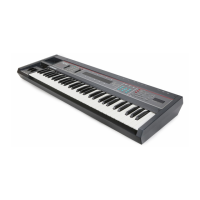SQ-80 — Musician's Manual
ow follow the same procedure outlined earlier, except that instead of pressing INTERNAL, first press
CART A or CART B.
To Select a Cartridge Sound:
> Press CART A or CART B.
> Press
Bank Select #1, 2, 3, or 4 .
> Select a Program by pressing the Button above or below a Program Name.
Cartridge Insertion and Removal
The Program Cartridge can be inserted or removed at any time (except while you're Writing Programs
to it), even when the
SQ-80's power is On. without doing any harm to the SQ-80 or the Cartridge. If the
Cartridge is removed while a Cartridge Program is selected. the Display instantly switches to Internal
Bank #1. The Cartridge Sound will disappear, and will be replaced by the first sound in Bank 1, which
becomes the selected Program.
ESQ Compatibility - Sounds and Sequences
The
SQ-80 will play Programs created for the ENSONIQ ESQ-1 or ESQ-M. The reverse, however.
is not always the case. The
SQ-80 has a great many Waves and a number of Program parameter values
that the
ESQ-1 doesn't. Many Programs created on the SQ-80 will produce unpredictable results on the
ESQ-1 since it will not understand some of the parameters contained in them. Playing SQ-80 Programs
on an
ESQ-1 or ESQ-M will not harm the ESQ in any way. However, they probably won't sound right,
articularly those that use Waves other than the 32 Waveforms contained in the ESQ.
With Sequences it's a similar story. You can send
ESQ-1 Sequences to the SQ-80 via MIDI, or load
them into the
SQ-80 from Tape or from a Mirage. The SQ-80 will convert the ESQ Sequences into its
own format. Bear in mind that the proper Internal and/or Cartridge Programs must be in place for the
Sequences to play properly on the
SQ-80.
Going the other way , you can send one Sequence (Current Seq) via MIDI or Tape from the
SQ-80 to
an
ESQ-1, but you cannot send the entire Sequencer memory (All Sequencer Data) from the SQ-80 to
an
ESQ-1. Thus if you have Sequences and Songs in the SQ-80 that you want to send to the ESQ-1, you
will have to transfer the Sequences one at a time, and then reconstruct any Songs on the
ESQ-1. Bear
in mind that
SQ-80 Programs that were used in any such Sequences will probably not play properly on
the
ESQ-1, so you will have to either assign new Programs to such Tracks, or assign the Tracks MIDI
Status and play the
SQ-80 (if it's available) from the ESQ-1 Sequencer.
Pressure (After-touch)
One of the most exciting features of the
SQ-80 is its keyboard, which, in addition to responding to the
velocity with which you play. is capable of generating two types of Pressure —
Key Pressure and
Channel Pressure. Pressure (often called After-touch) is a modulator which allows you to change the
sound in various ways by pressing down harder on a key or keys after the initial keystrike.
Like the MOD Wheel or Foot Pedal. Pressure is a Modulator, and can be chosen wherever a Modulator
is selected in the Voice section of the
SQ-80. Pressure can be assigned to alter the pitch or volume o
Oscillators, the Filter Cutoff frequency, LFO depth, Pan location. etc.
There are two types of Pressure:
• CHANNEL PRESSURE, also called Mono Pressure, is "global." Channel Pressure affects all notes
that are playing when you exert pressure on any of the keys. If, for example. you play a three-note chord.
ressing down harder on any of the three notes of the chord will modulate all three notes. This type of
Section 1 — First Things First 9

